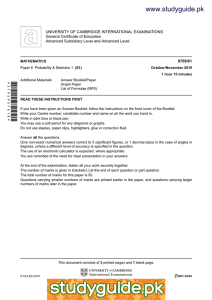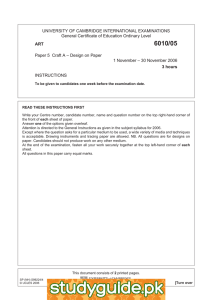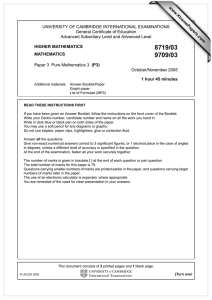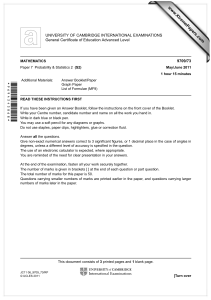www.XtremePapers.com
advertisement
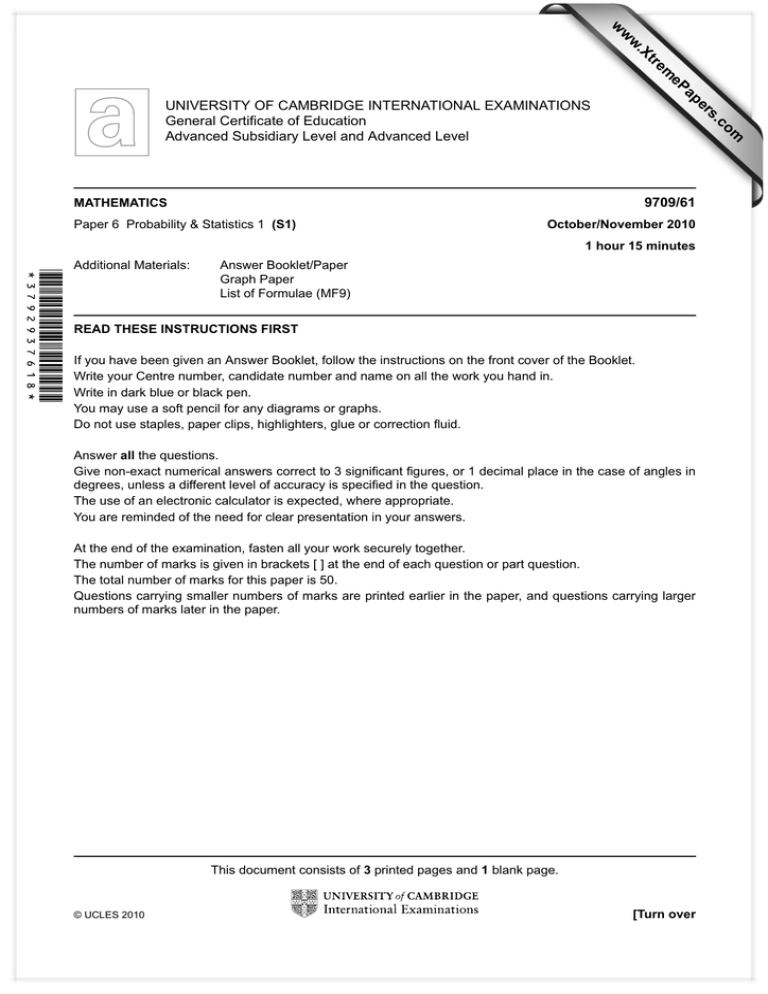
w w ap eP m e tr .X w om .c s er UNIVERSITY OF CAMBRIDGE INTERNATIONAL EXAMINATIONS General Certificate of Education Advanced Subsidiary Level and Advanced Level 9709/61 MATHEMATICS Paper 6 Probability & Statistics 1 (S1) October/November 2010 1 hour 15 minutes *3792937618* Additional Materials: Answer Booklet/Paper Graph Paper List of Formulae (MF9) READ THESE INSTRUCTIONS FIRST If you have been given an Answer Booklet, follow the instructions on the front cover of the Booklet. Write your Centre number, candidate number and name on all the work you hand in. Write in dark blue or black pen. You may use a soft pencil for any diagrams or graphs. Do not use staples, paper clips, highlighters, glue or correction fluid. Answer all the questions. Give non-exact numerical answers correct to 3 significant figures, or 1 decimal place in the case of angles in degrees, unless a different level of accuracy is specified in the question. The use of an electronic calculator is expected, where appropriate. You are reminded of the need for clear presentation in your answers. At the end of the examination, fasten all your work securely together. The number of marks is given in brackets [ ] at the end of each question or part question. The total number of marks for this paper is 50. Questions carrying smaller numbers of marks are printed earlier in the paper, and questions carrying larger numbers of marks later in the paper. This document consists of 3 printed pages and 1 blank page. © UCLES 2010 [Turn over 2 1 Anita made observations of the maximum temperature, t ◦ C, on 50 days. Her results are summarised by Σ t = 910 and Σ(t − t )2 = 876, where t denotes the mean of the 50 observations. Calculate t and the standard deviation of the observations. [3] 2 On average, 2 apples out of 15 are classified as being underweight. Find the probability that in a random sample of 200 apples, the number of apples which are underweight is more than 21 and less than 35. [5] 3 The times taken by students to get up in the morning can be modelled by a normal distribution with mean 26.4 minutes and standard deviation 3.7 minutes. (i) For a random sample of 350 students, find the number who would be expected to take longer than 20 minutes to get up in the morning. [3] (ii) ‘Very slow’ students are students whose time to get up is more than 1.645 standard deviations above the mean. Find the probability that fewer than 3 students from a random sample of 8 students are ‘very slow’. [4] 4 The weights in grams of a number of stones, measured correct to the nearest gram, are represented in the following table. Weight (grams) Frequency 1 − 10 11 − 20 21 − 25 26 − 30 31 − 50 51 − 70 2x 4x 3x 5x 4x x A histogram is drawn with a scale of 1 cm to 1 unit on the vertical axis, which represents frequency density. The 1 − 10 rectangle has height 3 cm. 5 (i) Calculate the value of x and the height of the 51 − 70 rectangle. [4] (ii) Calculate an estimate of the mean weight of the stones. [3] Three friends, Rick, Brenda and Ali, go to a football match but forget to say which entrance to the ground they will meet at. There are four entrances, A, B, C and D. Each friend chooses an entrance independently. • The probability that Rick chooses entrance A is 31 . The probabilities that he chooses entrances B, C or D are all equal. • Brenda is equally likely to choose any of the four entrances. • The probability that Ali chooses entrance C is 72 and the probability that he chooses entrance D is 35 . The probabilities that he chooses the other two entrances are equal. (i) Find the probability that at least 2 friends will choose entrance B. [4] (ii) Find the probability that the three friends will all choose the same entrance. [4] © UCLES 2010 9709/61/O/N/10 3 6 Pegs are to be placed in the four holes shown, one in each hole. The pegs come in different colours and pegs of the same colour are identical. Calculate how many different arrangements of coloured pegs in the four holes can be made using (i) 6 pegs, all of different colours, [1] (ii) 4 pegs consisting of 2 blue pegs, 1 orange peg and 1 yellow peg. [1] Beryl has 12 pegs consisting of 2 red, 2 blue, 2 green, 2 orange, 2 yellow and 2 black pegs. Calculate how many different arrangements of coloured pegs in the 4 holes Beryl can make using 7 (iii) 4 different colours, [1] (iv) 3 different colours, [3] (v) any of her 12 pegs. [3] Sanket plays a game using a biased die which is twice as likely to land on an even number as on an odd number. The probabilities for the three even numbers are all equal and the probabilities for the three odd numbers are all equal. (i) Find the probability of throwing an odd number with this die. [2] Sanket throws the die once and calculates his score by the following method. • If the number thrown is 3 or less he multiplies the number thrown by 3 and adds 1. • If the number thrown is more than 3 he multiplies the number thrown by 2 and subtracts 4. The random variable X is Sanket’s score. (ii) Show that P(X = 8) = 29 . [2] The table shows the probability distribution of X . (iii) Given that E(X ) = 58 9, x 4 6 7 8 10 P(X = x) 3 9 1 9 2 9 2 9 1 9 find Var(X ). [2] Sanket throws the die twice. (iv) Find the probability that the total of the scores on the two throws is 16. [2] (v) Given that the total of the scores on the two throws is 16, find the probability that the score on the first throw was 6. [3] © UCLES 2010 9709/61/O/N/10 4 BLANK PAGE Permission to reproduce items where third-party owned material protected by copyright is included has been sought and cleared where possible. Every reasonable effort has been made by the publisher (UCLES) to trace copyright holders, but if any items requiring clearance have unwittingly been included, the publisher will be pleased to make amends at the earliest possible opportunity. University of Cambridge International Examinations is part of the Cambridge Assessment Group. Cambridge Assessment is the brand name of University of Cambridge Local Examinations Syndicate (UCLES), which is itself a department of the University of Cambridge. 9709/61/O/N/10
